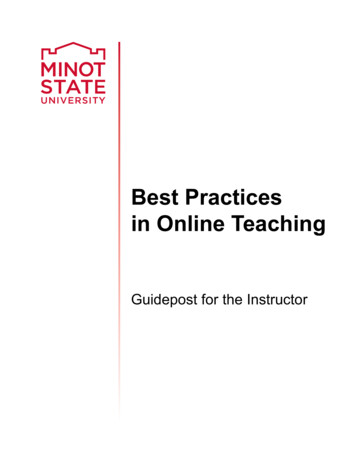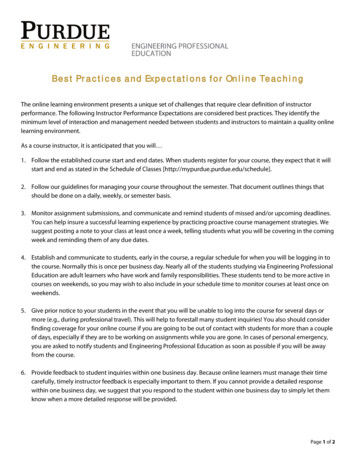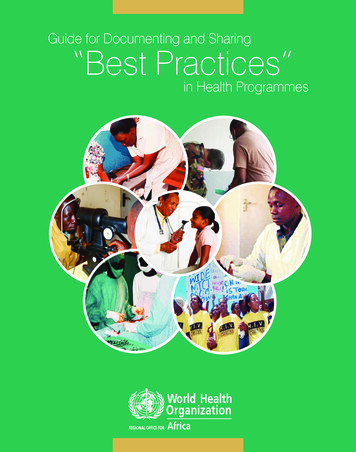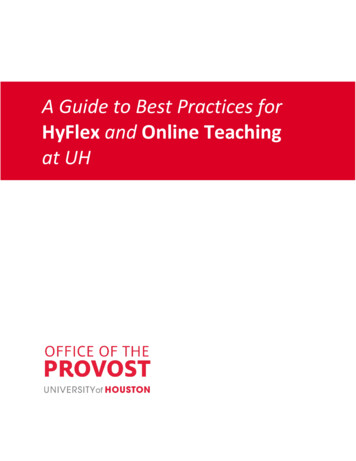
Transcription
1101 Pennsylvania Ave. NW, Suite 600 Washington, DC 20004P 202.756.2971 F 866.808.6585 www.hanoverresearch.comBest Practices in Online TeachingStrategiesIn the following report, The Hanover Research Council reviews the best practiceteaching strategies in the field of online education.MARKET EVALUATION SURVEYING DATA ANALYSIS BENCHMARKING INNOVATIVE PRACTICES LITERATURE REVIEW
HANOVER RESEARCHJULY 2009IntroductionIn February 2002, The Times Educational Supplement reported that ―there is growingevidence from research in [e-learning] that certain strategies will enhance teachingand learning - just as certain tactics and strategies do work in face-to-face pedagogy.‖1The article emphasized that successful e-learning must involve ―a mixture of coursedesign issues and pedagogical issues.‖ In order to entice students to participate, acourse must offer ―group activities, structure, stimuli, cajoling by tutors andpeers [and] a purpose or a reason to go online.‖2The importance of instructional strategies to the success of the online environmenthas precipitated the creation of best practices guidelines for all aspects of theinstructional process, including the planning and management of online instruction,online teaching techniques, and online student assessment and evaluation techniques.This report reviews the current literature on successful strategies for online teachingin the following sections: Section One: Overview of the Principles, Guidelines, and Benchmarksfor Online Education: This section leads into a discussion of specific bestpractices for online teaching with a review of the variety of guidelines andprinciples of online education. Special emphasis is placed on current andfuture trends in effective online pedagogy. Section Two: Best Practices in Online Teaching Strategies: This sectionreviews proven strategies for three major components of the instructionalprocess: the planning and management of online instruction, the actualteaching process, and student assessment and evaluation. Section Three: An Exemplary Program and Examples of EffectivePractices: The final section provides examples of an award-winning onlineeducation program and the teaching practices of three award-winninginstructors.Vic Lally and Jerry Wallington, ―Enticing E-learning,‖ The Times Educational Supplement, February 8, 2002,Pg.232 Ibid.1 2009 The Hanover Research Council – Academy Administration Practice2
HANOVER RESEARCHJULY 2009Section One: Overview of the Principles, Guidelines, and Benchmarksfor Online EducationNumerous educational agencies, from those that focus solely on online education,such as the Sloan Consortium,3 to the Institute for Higher Education Policy,4 haveprovided general guidelines and benchmarks for online education. In particular, theSloan Consortium is nationally recognized as a resource for online education throughits annual Sloan-C awards for programs and instructors that have made ―outstandingcontributions to the field of online learning.‖5 As a beginning to our discussion ofbest practice online teaching strategies, we profile one of the winners of the SloanConsortium‘s Award for Excellence in Online Teaching as a case study example ofrecommended teaching strategies in action.6In 2003, the Consortium presented Bill Pelz, a Professor of Psychology at HerkimerCounty Community College, with the award. Pelz shared his three ―Principles ofEffective Online Pedagogy‖ in a 2004 report.Pelz‘s first principle is to ―let the students do (most of) the work.‖7 As he asserts,―the more ‗quality‘ time students spend engaged in content, the more of that contentthey learn.‖ Pelz provides specific examples of activities for which the students dothe work while the professor provides support:8 Student Led DiscussionsStudents Find and Discuss Web ResourcesStudents Help Each Other Learn (Peer Assistance)Students Grade Their Own Homework AssignmentsCase Study AnalysisThe second principle is that ―[i]nteractivity is the heart and soul of effectiveasynchronous learning,‖ but Pelz stresses that interaction must stretch beyond simplestudent discussion:9Students can be required to interact with one another, with the professor,with the text, with the Internet, with the entire class, in small groups orteams, one-on-one with a partner, etc. In addition to discussing the coursecontent, students can interact regarding assignments, problems to solve, caseFor more information, please see: The Sloan Consortium. ―Home.‖ See http://www.sloan-c.org/ For more information, please see: Institute for Higher Education Policy. ―Home.‖ See http://www.ihep.org/ 5 The Sloan Consortium. ―Home.‖ Op.cit.6 For more information, please see: The Sloan Consortium. ―Sloan-C Awards.‖ See http://www.sloanc.org/aboutus/awards.asp 34Bill Pelz ―(My) Three Principles Of Effective Online Pedagogy,‖ Journal of Asynchronous Learning Networks,Volume 8, Issue 3: June 2004.8 Ibid.9 Ibid.7 2009 The Hanover Research Council – Academy Administration Practice3
HANOVER RESEARCHJULY 2009studies, lab activities, etc. Any course can be designed with requiredinteractivity.Pelz‘s final principle is to ―strive for presence.‖ According to Pelz, there are threeforms of presence for which to strive in online learning environments: SocialPresence, Cognitive Presence, or Teaching Presence. These ideas are described indetail in Pelz‘s report:10 Social Presence: When participants in an online course help establish acommunity of learning by projecting their personal characteristics into thediscussion — they present themselves as ―real people.‖ There are at leastthree forms of social presence:o Affective. The expression of emotion, feelings, and mood.o Interactive. Evidence of reading, attending, understanding, thinkingabout others‘ responses.o Cohesive. Responses that build and sustain a sense of ‗belongingness,‘group commitment, or common goals and objectives Cognitive Presence: The extent to which the professor and the students areable to construct and confirm meaning through sustained discourse(discussion) in a community of inquiry.o Cognitive presence can be demonstrated by introducing factual,conceptual, and theoretical knowledge into the discussion.o The value of such a response will depend upon the source, clarity,accuracy and comprehensiveness of the knowledge. Teaching Presence: Teaching presence is the facilitation and direction ofcognitive and social process for the realization of personally meaningful andeducationally worthwhile learning outcomes. There are two ways that theprofessor and the students can add teaching presence to a discussion, asdisplayed in the following table.10Ibid. 2009 The Hanover Research Council – Academy Administration Practice4
HANOVER RESEARCHJULY 2009Figure 1.1: Components of Teaching PresenceFacilitating the discussionDirect instruction Identifying areas of agreement anddisagreement Seeking to reach consensus /understanding Encouraging, acknowledging andreinforcing student contributions Setting a climate for learning Drawing in participants / promptingdiscussion Assessing the efficacy of the process Presenting content and questions Focusing the discussion Summarizing the discussion Confirming understanding Diagnosing misperceptions Injecting knowledge from diverse sources Responding to technical concernsSource: Bill Pelz ―(My) Three Principles Of Effective Online Pedagogy,‖ Journal of Asynchronous LearningNetworks, Volume 8, Issue 3: June 2004.Interestingly, these three principles: (1) engage student in content, (2) promotestudent-teacher and student-student interaction, and (3) strive for presence, are alsofound in literature regarding benchmarks and recommendations for successful onlineteaching. For instance, the Institute for Higher Education Policy‘s 2000 report ofbenchmarks for successful online education emphasizes interaction and engagementin its best practices for online teaching/learning and course development:11Online Teaching/Learning Benchmarks Student interaction with faculty and other students is an essential characteristicand is facilitated through a variety of ways, including voice-mail and/or e-mail. Feedback to student assignments and questions is constructive and providedin a timely manner. Students are instructed in the proper methods of effective research, includingassessment of the validity of resources.Course Development Benchmarks Guidelines regarding minimum standards are used for course development,design, and delivery, while learning outcomes – not the availability of existingtechnology – determine the technology being used to deliver course content. Instructional materials are reviewed periodically to ensure they meet programstandards.Quoted verbatim from: The Institute for Higher Education Policy, ―Quality on the Line: Benchmarks forSuccess in Internet-Based Distance Education,‖ April 2000. Pg. 2-3. See http://www2.nea.org/he/abouthe/images/Quality.pdf 11 2009 The Hanover Research Council – Academy Administration Practice5
HANOVER RESEARCHJULY 2009 Courses are designed to require students to engage themselves in analysis,synthesis, and evaluation as part of their course and program requirements.Similarly, the Online Journal of Distance Learning Administration’s ―Checklist for OnlineInteractive Learning‖ (COIL), a best practice guideline for online faculty evaluation,emphasizes the importance of Pelz‘s principles of engagement, interaction, andpresence, particularly in Categories Two and Four, as reviewed in the figure below.12Figure 1.2: Checklist for Online Interactive Learning (COIL)COIL CategoriesCategory 1: Student Behaviors Meet CriterionDemonstrate their prerequisite technology skills at beginning are adequate for hardware, software and website use.Seek opportunities to, and support for, interacting with instructor and other students.Actively participate in all online activities.Actively involved through writing and interaction in web-based courses (improves student writingperformance).Use a variety of communication techniques to enhance online learning.Personalize themselves by publishing online biographies and photographs to allow other members of theclass to visualize them.Seek assistance in understanding and mastering different learning strategies.Demonstrate prerequisites and become more proficient in technology communication skills.Category 2: Faculty-Student InteractionsProvide clear and adequate guidance.Use action research regularly to evaluate the success/failure of the course and meet student concerns.Personalize communications by/with student-student and student-teacher.Use variety of communication techniques to provide for greater empathy and personal approach than e-mailand web site alone.Plan for increased time for student interactions as compared to traditional courses.Clearly delineate institutional policy on cheating and plagiarism at start of course.Maintain separate e-mail account for web courses.Forward responses to frequently asked questions to all students to avoid duplication.Give faculty reduced load and increased support to develop course materials.Provide students with continuous, frequent support, feedback.Scaffold virtual discourse construction.Emphasize importance of good study skills throughout courseClosely monitor each student‘s progress.Create opportunities to coach and facilitate student construction of knowledge.Give negative comments to students privately, preferably by phone.Clearly delineate course requirements.Thomas J. Tobin, ―Best Practices for Administrative Evaluation of Online Faculty,‖ Online Journal of DistanceLearning Administration. Volume 7, No 2., Summer 2004. See http://www.westga.edu/ distance/ojdla/summer72/tobin72.html 12 2009 The Hanover Research Council – Academy Administration Practice6
HANOVER RESEARCHJULY 2009COIL CategoriesCategory 3: Technology SupportInsure a low level of technological difficulties in accessing web site and communication.Provide adequate, friendly, easy, continuous technical support.Category 4: Learning EnvironmentUse structured activities to provide an effective framework for online learning.Mandate smaller class sizes for online courses to give faculty appropriate time to deliver quality instructionboard.Use flexible deadlines to motivate students, maintain communication, and allow for technical problems.Create social interaction through group collaboration to facilitate high achievement.Use streaming audio for reading onlinePresent course content in a manner that hierarchically structures the sequence of information.Organize web site to enable student to interact with the content, other students, and instructor.Create welcoming, safe, nurturing online environment.Present problem-solving situations in a realistic context.Provide opportunities for students to question instructor to insure accuracy of understanding.Create opportunities for students to communicate with each other to share understanding of course content.Provide opportunities to collaboratively construct knowledge based on multiple perspectives, discussion andreflection.Provide opportunities for students to articulate and revise their thinking to insure accuracy of knowledgeconstruction.Ensure equitable environment exists for gender differences in learning styles, reduction of barriers toparticipation, and communication.Include cooperative and collaborative learning to distribute workload through group and support femalestudents‘ preferred method of connected learning.Promote gender equality by encouraging females to post messages while asking males to subside if a patternof male domination is noticed.Insure an equitable learning environment exists for all.Allow time for reflection at end of course.Include ―warm-up‖ period with light-hearted exercises aimed to help student get to know one another.Start online course with all students together at the same time.Provide equal access to the shared conversation in the course.Provide opportunities for students to control online learning and structure it for themselves.Provide discussion forums encouraging open and honest dialogue.Conduct a teleconference during and at the end of the course to discuss successes and problems.Use computer conferencing to develop overall critical thinking skills.Source: Thomas J. Tobin, ―Best Practices for Administrative Evaluation of Online Faculty.‖ Online Journal of DistanceLearning Administration. Volume 7, No 2. Summer 2004. Op.cit.Finally, Pelz‘s principles for online teaching are complimented by recommendationsfor the key characteristics used in effective online teaching, encapsulated in theacronym VOCAL (Visible, Organized, Compassionate, Analytical, and Leader-byexample).13 Based on ten years of teaching experience in web-enhanced, blendedJohn R. Savery. ―Be VOCAL: Characteristics of Success Online Instructors.‖ Journal of Interactive Online Learning. 4:2,Fall 2005. Pg. 141. See http://www.ncolr.org/jiol/issues/PDF/4.2.6.pdf 13 2009 The Hanover Research Council – Academy Administration Practice7
HANOVER RESEARCHJULY 2009learning, and entirely online classrooms, VOCAL integrates the existing foundationof best practices with the design of learning environments that foster studentownership.14 The five components of VOCAL are discussed in greater detailbelow:15 Visible: The online classroom differs from the traditional classroom in thattext largely replaces in-person, face-to-face, verbal communication. Thisdifferent dynamic makes it easier for students to feel as if the instructor is notparticipating in learning, thus making it more likely that students take a passiverole as well. A lack of visibility may lead to students‘ critical attitudes of theinstructor‘s effectiveness and lower levels of affective learning.Visibility can be demonstrated through public and private communicationchannels, such as:o A section of the course website with personal and professionalinformation about the instructor.o Timely return of assignments and feedback.o Regular course website updates and postings, and well as regular updatesto a shared assignment calendar.o Mass and personal email communications with all students. Organized: Because online learners generally choose to take an online coursebecause they assume it will provide more flexibility for their busy schedules,they also need to know what is expected of them so that they can organizetheir time to meet course requirements. This increased time managementresponsibility of the learner also means that there is an increased organizationresponsibility on the instructor. In order to meet the needs of students, it issuggested that online instructors:o Require students to take an online self-assessment and report what theythink are the characteristics of a successful online student.o Prepare syllabus and assignment due dates carefully and well in advance sothat students know what to expect and when.1415Ibid.Ibid. Pg. 142-149. 2009 The Hanover Research Council – Academy Administration Practice8
HANOVER RESEARCHJULY 2009o Prepare a documents of ―Do‘s and Don‘ts‖ for the course, including therules of web etiquette, posting comments in discussion forums, andcommunicating concerns to the instructor.o Anticipate the need for a non-instructional venue for online discussions.o Use different formats for online resources and label each clearly so thatstudents can select a format that is most useful to them (i.e. pdf, html, doc,ppt).o Fully use the capabilities of the available educational technology toenhance student learning. Compassionate:Online environments can be surprisingly intimate,especially since email provides a combination of privacy and distance thatdoes not exist in traditional classrooms. This intimacy increases the need forinstructors to be compassionate of students‘ feelings and needs. This can beaccomplished through:o Permission for students to communicate directly with the instructor.o Discussion forums in which students introduce themselves and providepersonal information, or use ―ice-breaker‖ techniques to get students toshare personal information with each other.o Reminding, if necessary, student of the class expectations of conduct,participation, and the instructor‘s response to unanticipated problems. Analytical: Instructors need to manage the online learning assignment toensure that students are completing assignments and achieving learningoutcomes. This includes the timely return of assignments as well as theanalysis of student data. While many course management systems providetools for assessment and analysis, it is the instructor‘s responsibility todetermine if the assessment if appropriate to the subject. Suggested strategiesinclude:o The use of smaller and more frequent assignments throughout the courseto reduce test anxiety and provide learners with opportunities to processcourse concepts and content.o The use of satellite offices, if possible, to administer face-to-face exams.o Specify the format and file naming conventions for assignments submittedonline to help easily organize and alphabetize assignments. 2009 The Hanover Research Council – Academy Administration Practice9
HANOVER RESEARCHJULY 2009o Provide opportunities for students to provide feedback on the course.o Provide clear expectations and guidelines for assessing participation. Leader-by-Example: The online instructor sets the tone for studentperformance through teacher-student interactions. Consequently, instructorsshould attempt to model best practice strategies to assist student learning.Ways in which instructors can model good online learning and behaviorinclude:o Introductions in which the instructors shares personal information withstudents both formally and informally.o Model responsibility by returning assignments within the communicatedestablished time period.o Model the right way students should communicate online.o Use public and private communication to ensure visibility.o Plan for and implement an activity at the end of the course that bringsclosure to the class, reinforces what was learning, and acknowledges thecontributions of students.Not only are variations on these three best practice principles of online teachinghighlighted in current recommendations – they are also integrated into projections ofpedagogical techniques in online teaching which will be used in the coming decade.For instance, a survey of instructors and administrators in postsecondary institutionsprimarily belonging to the Multimedia Educational Resource for Learning and OnlineTeaching (MERLOT) and the Western Cooperative for EducationalTelecommunications (WCET) estimated that the following teaching strategies, inorder of importance, will play a significant role in the future of online teaching.16 It isinteresting to note the continued importance of interactivity in online instruction, asseen in elements such as group problem-solving and collaborative tasks, coaching ormentoring, and discussion. Group problem-solving and collaborative tasks; Problem-based learning; Discussion;Kyong-Jee Kim and Curtis Bonk, ―The Future of Online Teaching and Learning in Higher Education,‖ EducauseQuarterly, Number 4, 2006. See http://connect.educause.edu/Library/EDUCAUSE Quarterly/TheFutureofOnlineTeaching/40000?time 1227025492 16 2009 The Hanover Research Council – Academy Administration Practice10
HANOVER RESEARCH JULY 2009Case-based strategies;Simulations or role play;Student-generated content;Coaching or mentoring;Guided learning;Exploratory or discovery;Lecturing or teacher-directed activities;Modeling of the solution process; andSocratic questioning.The next section of this report will review in greater detail the use of the previouslydiscussed principles of best practice online teaching as they relate to each componentof the instructional process. 2009 The Hanover Research Council – Academy Administration Practice11
HANOVER RESEARCHJULY 2009Section Two: Best Practices in Online Teaching StrategiesThe literature regarding best practices in online teaching strategies can be organizedinto three major components of the instructional process: (1) planning anddevelopment, (2) teaching in action, and (3) student assessment and data evaluation.Together, these three components significantly influence the effectiveness of theonline environment, making it especially important that instructors are aware of bestpractice teaching strategies, discussed in the following sections.2.1: Best Practices in Planning and DevelopmentOne of the most important elements of planning and managing online courses isinstructors‘ recognition of the fact that although there are a wide array of educationaltechnologies and course management tools available for online teaching, not all ofthese technologies are appropriate matches to the subject taught and the teacher‘spedagogical style and strategies. As such, it is very important that instructors ensurethat pedagogical principles drive the use of technology rather than the other wayaround. Instructors must strive to achieve certain learning standards, regardless ofthe medium through which they are teaching.17 Because of this, course planningshould take place before instructors select the technology and course managementsystem that will be used for the course.18The first step in the planning process involves the development of learningobjectives. The importance of learning objective development and communication ishighlighted throughout the literature, including Park University‘s guidelines for thecreation of learning objectives:19 Behavior: Learning objectives should be written in terms of observablebehavioral outcomes. Clear, targeted verbs should be used to communicatewith students the expected outcomes of learning activities. Student-Centered: All learning objectives should focus on the student.Effective objectives explain expectation for student behavior, performance,and understanding. Conditions: Learning objectives should be specific and should target oneaspect of understanding. The conditions of the objective include the tools,references, and/or aids that will be provided to the student.Richard Ascough. ―Designing for Online Distance Education: Putting Pedagogy Before Technology.‖ TeachingTheology & Religion. Volume 5, No 1. 2002. Pg. 17. See http://post.queensu.ca/ rsa/2002 TTR Ascough.pdf 18 Ibid.19 Park University. ―Faculty Resources Quick Tips: Learning Objectives – Guidelines for Writing Effective LearningObjectives.‖ See obj.html 17 2009 The Hanover Research Council – Academy Administration Practice12
HANOVER RESEARCHJULY 2009 Standards: Each learning objective should be measurable and should includethe criteria for student assessment. Standards are important because they bothinform students of performance expectations while providing insight as tohow these expectations will be measured.Following the development of clearly defined learning objectives and the specialneeds of students (e.g. consideration of the needs of students with disabilities orvisual impairments if they are enrolled in the course), instructors may begin to selectthe technological option best-suited for the course.It is important to note, however, that although there is tremendous variety in theeducational technologies available to online instructors, the field of distance learningtechnology is changing quickly, and it is therefore necessary for instructors andadministrators to keep a close eye on emerging trends and associated best practices. 20For example, the annual Horizon Report, a long-running qualitative research projectthat seeks to identify and describe emerging education technologies, projects thatmobile technologies, cloud computing, geocoded data, personal web programs,semantic-aware applications, and smart objects will significantly impact the choices ofeducational institutions within the next five years.21While these six technologies in online education are still emerging as educationaltools, online technologies such as web-pages, discussion forums, course managementsystems, audio tools, and video tools are well-entrenched in the field of onlineinstruction. However, with each technology comes a number of planningconsiderations that are important for online instructors to reflect upon as theydevelop their courses and choose the most appropriate technologies.The University of Washington‘s ―Learning and Scholarly Technologies,‖ a websitethat provides a help center for online instructors, addresses a number of thesetechnological considerations, reviewed in the figure below.22David Porter. ―Innovations, Trends, and Creativity in Distance Learning.‖ Paper presented at the 4th InternationalConference on Education and Technology – Inter-American University of Puerto Rico. September 7, 2006. Pg. 2. See http://www.bccampus.ca/Assets/BCcampus Whitepapers/Innovations !2c Trends !2c and Creativity in Distance Learning report.pdf 21 ―The Horizon Report: 2009 Edition.‖ Collaboration between the New Media Consortium and the Educause LearningInitiative. Pg. 3-4. See http://www.nmc.org/pdf/2009-Horizon-Report.pdf 22 University of Washington Learning & Scholarly Technologies. ―Choose Technologies for Your Distance LearningCourse.‖ See http://catalyst.washington.edu/help/teaching guides/dltech choices.html 20 2009 The Hanover Research Council – Academy Administration Practice13
HANOVER RESEARCHJULY 2009Figure 2.1.1: Considerations for Online TechnologiesTechnology OptionWeb Page: Allows teachers to easilycommunicate information in a centrallocation, update material, and to use thepage as a portal for other technologiesused in the class.Print: One of the most inexpensive andaccessible mediums for delivering distancelearning course content.Course Readings on the Web:Provides students with 24-hour access tomaterialsImages: Can be useful incommunicating information that isdifficult to explain using text or audioAudio: Provides flexibility to busystudentsVideo: Allows for face-to-faceinteractions with studentsOnline discussion: Allows studentsto easily communicate with each other andwith the instructorPeer Review: Allows student to viewthe same online document and submitcomments asynchronouslyPlanning Considerations Gather all content in a single folder to save time when building the web page. Consider specific web design patterns or other rules established by thedepartment. Organize content into sections (e.g. Syllabus, Assignments, Lecture schedule,etc.). Plan how you would like the pages to be organized and linked together.This process should be started through the creation of a site map. Consider your audience‘s perspective: what information will students need? Borrow ideas from other instructors (the World Lecture Hall is a goodresource). Link to other resources, including the institution‘s library‘s electronic reserves. Keep images small, but also consider issues of access for the visually impaired. Direct students to necessary plug-ins or helper applications. Teachers should keep in mind that text materials are static and may be lessappropriate for teaching languages and visual concepts. If using textbooks and readers, choose texts and readings that will be relevantand available over several years. If creating a course reader, ensure that thereis enough time to secure copyright permissions. Printed course and study guides may be a good way to organize the content ofthe course. Workbooks can be used to supplement course materials or as self-guidedcourses. Periodicals can be used to supplement distance learning course material. Allows teachers to easily modify the reading list Concept maps, flow charts and photos can make a website more accessible tostudents Determine the appropriate file format for pictures Economize file size with image resolution Consider copyright issuesThe following audio devices may be used: Telephone conferencing
Consortium's Award for Excellence in Online Teaching as a case study example of recommended teaching strategies in action.6 In 2003, the Consortium presented Bill Pelz, a Professor of Psychology at Herkimer County Community College, with the award. Pelz shared his three ―Principles of Effective Online Pedagogy‖ in a 2004 report.











